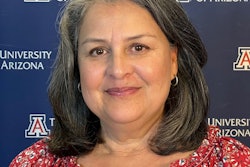Title: Associate professor, University of Massachusetts, Amherst
Education: Ph.D., biochemistry, cellular and molecular biology, Johns Hopkins University; B.S., physics, University of California at Santa Barbara
Age: 38
Career mentors: Susan Forsburg, University of Southern California; Thomas Pollard, Yale University; and Ralph Quatrano, Washington University-St. Louis
Words of wisdom/advice for new faculty members: “You will be successful if you follow your passion, and you will know you have chosen the right path if you look forward to going to work every day.”
Dr. Magdalena Bezanilla’s passion for science was cultivated in her father’s laboratory. Watching biophysicist Dr. Francisco Bezanilla study the squid’s giant axon, the largest known nerve cell in the animal kingdom, had a profound impact on Bezanilla’s professional future. To conduct his research, Bezanilla’s father moved the family from Los Angeles to a marine biological laboratory in Cape Cod, Mass., every summer.
“That’s where I got to see what was going on in my dad’s lab,” says Bezanilla, associate professor of biology at the University of Massachusetts, Amherst. “My dad tried to keep me out of the lab as much as possible because I was a bit of a distraction to everybody.”
But Bezanilla’s affinity for science could not be stifled. She kept coming back.
Today, the 38-year-old biologist spends countless hours in her own lab studying the cell biology of plant cells. Her research seeks to answer a basic biological question: How do cells grow?
“We don’t know a lot about how cells become the shape that they are. This is a particularly relevant question for plants,” says Bezanilla. “What the ultimate shape of a leaf looks like depends on the shape of the individual cells that make up that leaf. My lab is interested in understanding how molecules inside the cell help to shape the cell and give the cell its final form.”
Bezanilla and her colleagues recently pioneered a technique they call multi-gene silencing to simultaneously silence genes in a multicellular organism.
“Oftentimes, you have several members of a gene family that work together to do one thing for the organism,” Bezanilla says. “If you just remove a single member, nothing really happens, and you can’t figure out what those particular genes are doing.”
Bezanilla adds, “But if you’re able to remove [silence] all of the members, then you can find out what happens to the plant. You can determine what those particular genes are doing.”
Colleagues say Bezanilla is a rising star in the field.
“Dr. Bezanilla has taken a significant risk in her studies of important cell biological processes,” says Rolf Karlstrom, chairman of the department of biology at Amherst. “Cell biologists studying cell polarity, for the most part, experiment on animal cells in culture or brewer’s or baker’s yeast. Instead, Dr. Bezanilla studies cell polarity in a non-vascular plant, the moss Physcomitrella patens.”
“Staking her career on a nonconventional research organism and reaping exceptional insights therefrom, exemplify [her] brilliant and courageous spirit,” Karlstrom added.
Bezanilla recently received a five-year Lucile Packard Foundation grant and a Faculty Early Career Development, or CAREER, award from the National Science Foundation. She received the American Society for Cell Biology Women in Cell Biology junior award and, most notably, the 2010 Presidential Early Career Award for Scientists and Engineers, or PECASE. The PECASE award allowed Bezanilla to meet President Barack Obama. Bezanilla describes meeting the president as “amazingly cool.”
Interestingly, biology was not Bezanilla’s first choice. As an undergraduate at the University of California, Santa Barbara, Bezanilla majored in physics. But the paucity of women in physics coupled with a burgeoning curiosity in biology led Bezanilla down a different path. In her doctoral program at Johns Hopkins University, she opted to study cellular and molecular biology instead.
“Part of my rationale for leaving physics was that it’s really lonely being a female scientist in physics,” says Bezanilla. “There aren’t a lot of female physicists. There were no other women to talk about my life with.”
When Bezanilla is not teaching classes or in her lab, she is with her family. Her husband, Wei-Lih Lee, also works at Amherst as an associate professor of biology.
“My life revolves around my kids,” says Bezanilla. “I have two boys, ages 8 and 4. My goal in life is to make them not want to do what I do. My husband is a scientist, too. My kids think that having a lab is a normal job.”


















